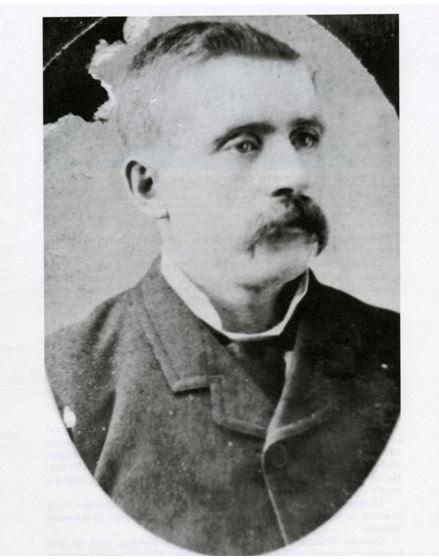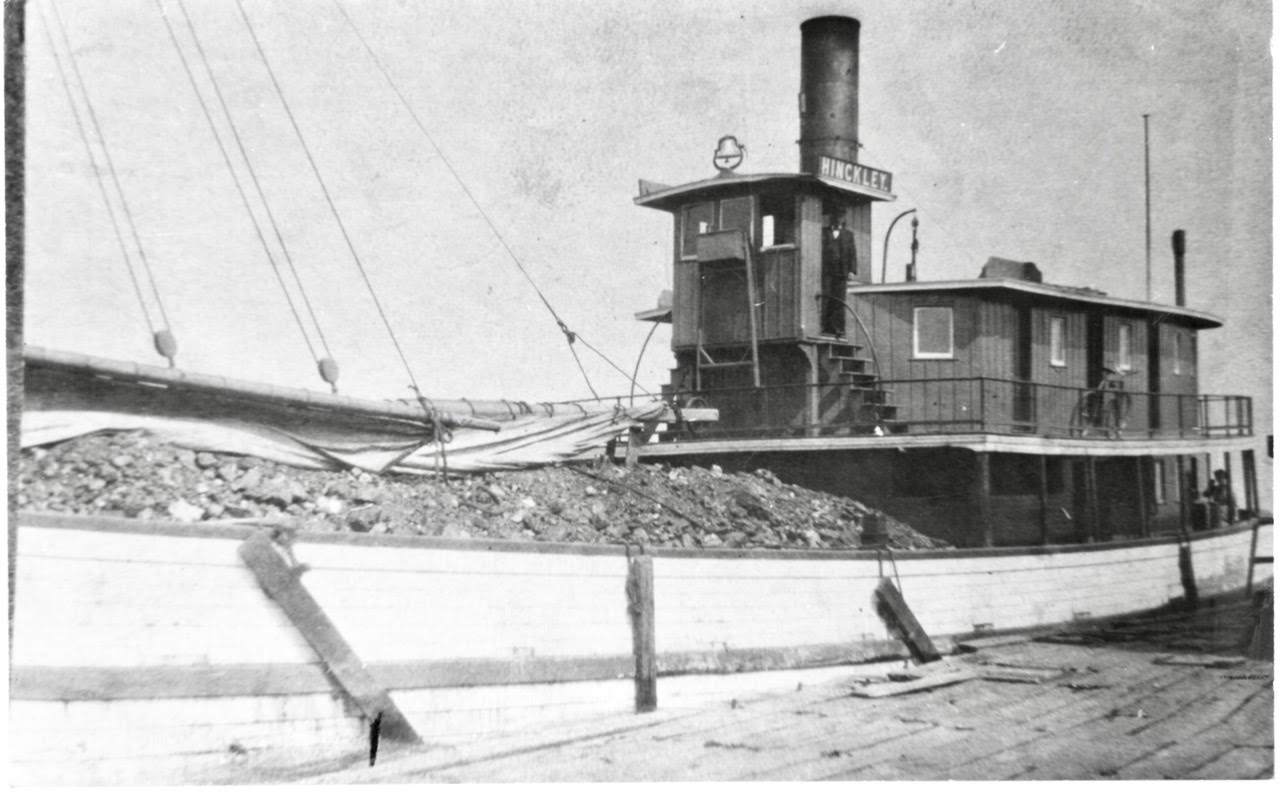The “rabbit” steamer Hinckley had been sailing went through a blinding snow- storm for hours; no land, beacon or buoy pointed the way. On every side, there was only whiteness. The captain guided his boat by dead reckoning while his crew prayed.
It was eight days before Christmas 1902, and the ship was en-route from Cape Vincent to its home port, Oswego. Even before they had cleared the Cape breakwater, the storm had begun. Heavy seas buffeted them as they steamed south. The course was determined by compass and by computation of distance traveled, estimated from the boat's speed. Suddenly the sea calmed, and the voyagers bumped against a mountain of ice.

Startled, but undaunted, the captain held his bow against the berg while a sailor scaled it. So thick was the falling snow that the sailor was unable to see but a few feet. He reported, however, that a mysterious tower-like structure stood at the edge of the ice. What this might be no one ventured to guess. But when further investigation revealed timbers beneath the ice, they drifted back until they reached the far side of the berg. There, to their mingled amazement, the crew found themselves at the entrance of Oswego harbor! The mysterious structure turned out to be the lighthouse.
Thus Captain Augustus R. Hinckley won another battle against the storm. He was one of the few men who had ever sailed blind from the St. Lawrence River to Oswego. None of his companions ever forgot the anxiety of that passage. Henry Lake, the mate who climbed the iceberg is said to have never sailed again.
Hinckley was one of the best known Lake Ontario captains. Despite the cloud of bad luck that followed him much of his life, he never gave up his love for the water. He knew the thrill of success against tremendous odds. Yet, a strangely maligned fate dogged his course, and through no fault of his own, he saw wealth wrenched from his grasp and his most ambitious ventures came to naught.

Augustus Hinckley was born on Wolfe Island, August 11, 1856, as the youngest son of a St. Lawrence River pilot of the old school. Even as a boy, his whole heart was set upon sailing. At an early age, he took great interest in all things nautical and was only a lad when he took up sailing as a career. His grandfather, Samuel, had been granted a license to run a ferry between the island and Kingston in the 1820s. The family retained the franchise for more than a century.
The captain's father, Coleman Hinckley, piloted steamboats up and down the St. Lawrence River for many years and was somewhat involved in shipbuilding. By the end of his career, Gus Hinckley had his own fleet of ships, as well as a government contract to place buoys in the St. Lawrence between Cape Vincent and Morristown. In addition, his skill as a salvager, in retrieving sunken ships, won him wide renown.
Captain Hinckley's ventures on Canadian waters brought him into conflict with the Canadian Pilots Association. One day, he recalled, a shot came across his bow, and he was escorted to Montreal. His dual citizenship of an earlier period came in handy for him. He proved to the authorities that he had as much right in Canadian waters as any other pilot who questioned him. He was never again bothered.
His first experience as a wrecker was with the steamship George T. Davie, of the Montreal Transportation Co. which sank with a cargo of grain near Alexandria Bay, in the St. Lawrence River on June 12, 1911. The Calvin Co. of Garden Island made several attempts to raise the barge and finally abandoned it. That November, Hinckley signed a contract to raise the vessel. Although the stern of the wreck lay on a ledge of rock, the bow was in 65 feet of water.
Hinckley said he had passed up and down the river, noting the fruitless efforts of Calvin to raise the Davie. When he received the contract, he brought 3 vessels and 16 men to the scene. After dry-docking the barge Jessie and schooner Bertie Caulkins at Kingston, he had holes bored through their bottoms at the stern, forming eight 10-inch wells in each. Through these were dropped two-inch iron chains, capable of lifting 50 tons. When Hinckley's little squadron finally anchored near the Davie, he was prepared to raise 1,000 tons. Divers were sent down to pass the chains beneath the wreck. Hatches were secured, pipes attached, and pumps started. As water came out of the hulk and jacks began to lift, the Davie came up between the two improvised wreckers.

At first, it rolled in the chains, going over to one side. Hinckley quickly assembled his discouraged crew, praised their efforts, and instructed them to lift carefully on the chains on one side. The Davie rolled back. Hinckley cleared several thousand dollars on this job. Such feats won for him a wide reputation as an expert salvager.
He lived in Oswego during most of his sailing days and is still remembered by older residents of that city as “the little old man with the leaky boats.”
After a number of financial setbacks, John S. Parsons, the noted Oswego ship chandler, ran the "Hinckley Line" for two or three years until Hinckley got back on his feet. "He didn't handle money too well," remembered Jack Donovan of Oswego, who worked for Parsons in his store, referring to Hinckley.
Donovan said, "I remember him as a little withered old man who used to come into the store to pay off Mr. Parsons with a gallon of maple syrup or a dozen eggs. Mr. Parsons was always willing to help down-and-out sailors," Donovan said. He added that one of Hinckley's problems with boats was that he would load them so heavy, there wouldn't be a foot of freeboard.
In 1917, Captain Hinckley purchased a run-down old farm, in the foothills of the Adirondacks, about three or four miles south of the village of Parishville, St. Lawrence County, N. Y., from the Jules Brown estate. He spent thousands of dollars renovating the house and it was a show place for those days. The farm included 100 acres of hardwoods that he expected to cut and use in his marine work. He finally moved there from Oswego in the early 1930s. "I'm keeping the farm for my old age," he used to say, "but Mrs. Hinckley asks me when does old age begin?"
About 1930-1931 he dug the Reed Canal at Henderson Harbor, and the "Cut" across Association Island Road to Lake Ontario. Claude Reed paid him $3,000 for this job.
The old mariner died on June 25, 1935, at the age of 78 and is buried in Hillcrest Cemetery in Parishville, along with his daughter, the late Isabelle Hinckley Place. Thus ended 66 illustrious years in the career of one of the most noted personalities on Lake Ontario and the St. Lawrence River.
Part I "A Hinkley Story" Volume 14, March 2019
Part II "Sinking of the Harvey J. Kendall, another Augustus Hinckley Story" Volume 14, April 2019
By Richard Palmer
Richard F. Palmer is a retired newspaper editor, and reporter, and was well known for his weekly historical columns for the “Oswego Palladium-Times”, called "On the Waterfront." His first article for TI Life was written in January 2015 and since then, he has written a half-dozen others. He is a voracious researcher and TI Life readers benefit from his interesting findings. Click here to see some of Richard Palmer’s TI Life Articles.
Posted in: Volume 14, Issue 5, May 2019, Places, People, Sports
Please click here if you are unable to post your comment.
